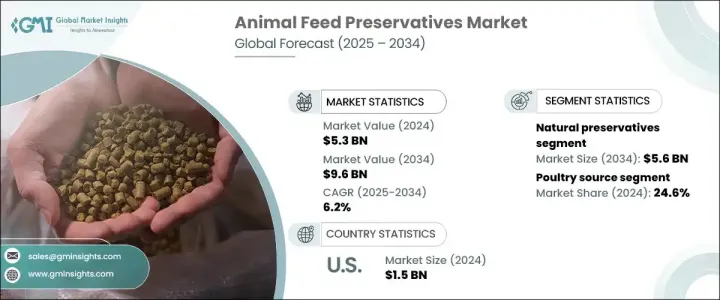
세계의 사료용 방부제 시장은 2024년에 53억 달러로 평가되었으며, 고품질 동물 영양에 대한 수요 증가와 사료 원료의 부패 방지 필요성으로 인해 2025년부터 2034년까지 연평균 복합 성장률(CAGR) 6.2%를 나타낼 것으로 예측됩니다.
가축생산이 세계적으로 확대되는 가운데, 사료의 안전성과 영양가를 확보하는 것이 농가나 업계 관계자의 최우선 사항이 되고 있습니다. 사료의 품질이 가축의 건강과 생산성에 미치는 영향에 대한 인식이 높아짐에 따라 효과적인 보존 솔루션에 대한 수요가 증가하고 있습니다. 또한 식품 유래 병원체와 미생물 오염에 대한 우려가 높아짐에 따라 축산업자는 보존 기간을 연장하고 사료의 품질을 유지하기 위해 방부제를 채용하고 있습니다.

이 성장은 사료의 안전성을 관리하는 규제 상황이 엄격해지고 있는 것 외에도 지속 가능한 축산 관행이 중시되는 것이 더욱 박차를 가하고 있습니다. 유기농과 깨끗한 라벨의 축산물로의 전환은 소비자의 선호도에 영향을 미치며 합성 대체품보다 천연 방부제의 사용을 권장합니다. 각 시장은 혁신에 초점을 맞추고 고급 보존 기술에 투자하고 진화하는 사료 업계의 요구를 충족시키기 위해 제품 포트폴리오를 확대하고 있습니다. 연구 중심의 접근법과 사료 제조업체 간의 파트너십 통합으로 향후 10년간 시장 성장이 더욱 가속될 것으로 예상됩니다.
| 시장 범위 | |
|---|---|
| 시작 연도 | 2024년 |
| 예측 연도 | 2025-2034년 |
| 시작 금액 | 53억 달러 |
| 예측 금액 | 96억 달러 |
| CAGR | 6.2% |
방부제의 유형에 따라 시장은 천연 및 합성 범주로 나뉩니다. 천연 방부제 부문은 2024년에 31억 달러를 창출했고, 2034년에는 56억 달러에 이를 것으로 예측됩니다. 유기농에서 화학물질이 없는 축산물에 대한 기호의 고조가 이 분야를 크게 견인하고 있습니다. 소비자와 축산업자들은 안전과 지속가능성의 이점으로부터 허브, 식물, 유기산 유래의 방부제를 점점 선호하고 있습니다. 합성 방부제에 대한 규제적 제한과 친환경 솔루션에 대한 세계의 관심 증가는 천연 대체물의 광범위한 채용을 촉진하고 있습니다. 이 분야의 기업은 기술의 진보를 활용하여 천연 방부제의 효율을 높이고 시장에서의 입지를 더욱 강화하고 있습니다.
동물 유형별로 시장은 가금류, 돼지, 소, 양식, 반려동물 사료, 말 등으로 분류됩니다. 가금류는 2024년 시장 점유율의 24.6%를 차지했으며, 이는 가금 제품의 왕성한 수요와 사료 효율 중시의 고조를 반영하고 있습니다. 돼지고기와 쇠고기 소비 증가와 성장과 생산성 향상을 위한 사료의 품질 향상에 대한 지속적인 노력으로 돼지와 소 분야도 크게 공헌하고 있습니다. 수산 양식과 반려동물 사료 분야도 동물의 건강과 성능을 향상시키기 위해 특수 사료 제형에 대한 투자가 증가하고 있으며, 유리한 부문으로 상승하고 있습니다.
미국의 사료용 방부제 시장은 2024년 15억 달러로 평가되었으며, 식육 제품의 소비 증가와 사료 안전성에 관한 규제 기준의 엄격화로 수요가 확대되고 있습니다. 농부와 사료 생산자는 미생물 오염과 영양 열화를 최소화하고 가축의 건강과 성능을 최적화하기 위해 방부제의 사용을 선호합니다. 사료의 장기 보존이 필요한 집약적 농업의 확대는 또한 효율적인 보존 방법의 필요성을 증가시키고 있습니다.
The Global Animal Feed Preservatives Market, valued at USD 5.3 billion in 2024, is projected to expand at a CAGR of 6.2% between 2025 and 2034, driven by the increasing demand for high-quality animal nutrition and the need to prevent spoilage of feed ingredients. With livestock production expanding worldwide, ensuring the safety and nutritional value of feed has become a top priority for farmers and industry stakeholders. The rising awareness regarding the impact of feed quality on animal health and productivity is pushing demand for effective preservation solutions. Additionally, as concerns over foodborne pathogens and microbial contamination grow, livestock producers are increasingly adopting preservatives to extend shelf life and maintain feed quality.

This growth is further fueled by the stringent regulatory landscape governing feed safety, along with the increasing emphasis on sustainable livestock practices. The shift towards organic and clean-label animal products is also influencing consumer preferences, encouraging the use of natural preservatives over synthetic alternatives. Market players are focusing on innovation, investing in advanced preservation technologies, and expanding product portfolios to cater to the evolving needs of the animal feed industry. The integration of research-driven approaches and partnerships with feed manufacturers is expected to further accelerate market growth over the next decade.
| Market Scope | |
|---|---|
| Start Year | 2024 |
| Forecast Year | 2025-2034 |
| Start Value | $5.3 Billion |
| Forecast Value | $9.6 Billion |
| CAGR | 6.2% |
Based on preservative type, the market is segmented into natural and synthetic categories. The natural preservatives segment generated USD 3.1 billion in 2024 and is expected to reach USD 5.6 billion by 2034. The growing preference for organic, chemical-free livestock products is significantly driving this segment. Consumers and livestock producers are increasingly favoring preservatives derived from herbs, plants, and organic acids due to their safety and sustainability benefits. Regulatory restrictions on synthetic preservatives, combined with the rising global focus on eco-friendly solutions, are encouraging the widespread adoption of natural alternatives. Companies within this segment are leveraging technological advancements to enhance the efficiency of natural preservatives, further strengthening their position in the market.
In terms of animal type, the market is categorized into poultry, swine, cattle, aquaculture, pet food, equine, and others. Poultry accounted for 24.6% of the market share in 2024, reflecting the strong demand for poultry products and the growing focus on feed efficiency. The swine and cattle segments are also making significant contributions, driven by the increasing consumption of pork and beef and the continuous efforts to enhance feed quality for improved growth and productivity. The aquaculture and pet food sectors are also emerging as lucrative segments, with rising investments in specialized feed formulations to enhance animal health and performance.
The U.S. animal feed preservatives market was valued at USD 1.5 billion in 2024, with demand escalating due to the increasing consumption of meat products and stricter regulatory standards for feed safety. Farmers and feed producers are prioritizing the use of preservatives to minimize microbial contamination and nutrient degradation, ensuring optimal livestock health and performance. The expansion of intensive farming practices, which necessitate longer feed storage durations, has also amplified the need for efficient preservation methods.